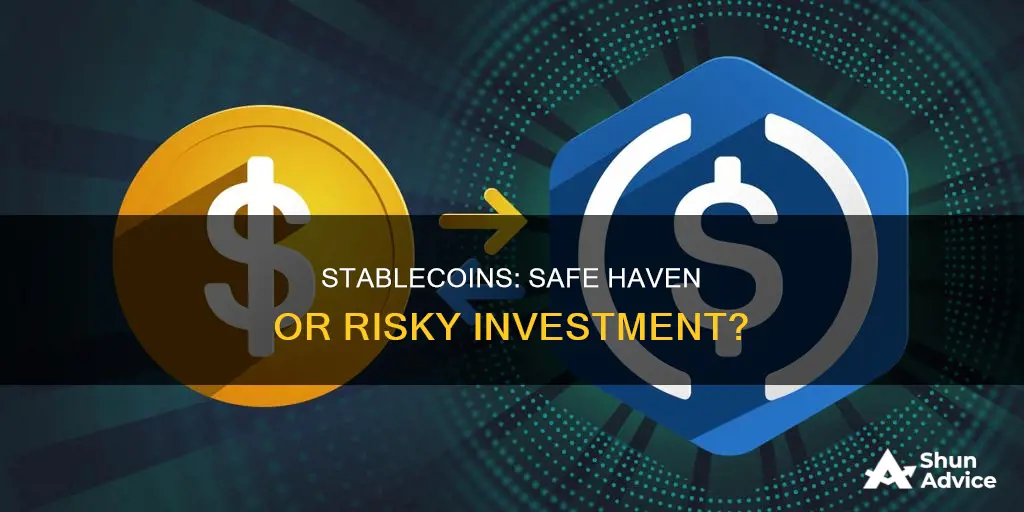
Stablecoins are a type of cryptocurrency designed to maintain a fixed value over time. Unlike highly volatile cryptocurrencies such as Bitcoin, the price of stablecoins is not meant to fluctuate. They are backed by reserve assets such as the U.S. dollar, making them less volatile than traditional cryptocurrencies. However, there are still risks to consider before investing in stablecoins. In this article, we will explore the pros and cons of investing in stablecoins and provide an overview of how they work. We will also discuss the different types of stablecoins and their potential benefits and drawbacks.
| Characteristics | Values |
|---|---|
| Volatility | Stablecoins are less volatile than traditional cryptocurrencies. |
| Investment | Stablecoins are not the best investment option. |
| Risk | Stablecoins are not risk-free. |
| Use case | Stablecoins are good for lending, borrowing, or financing. |
| Backing | Stablecoins are backed by multiple sources, including fiat currency, other cryptocurrencies, precious metals, and algorithmic functions. |
| Advantages | Stablecoins are decentralised, provide faster money transfers, and avoid financial service fees. |
| Interest | Stablecoins can generate passive income with interest rates ranging from 3% to 20%. |
What You'll Learn

Stablecoins are less volatile than traditional cryptocurrencies
Stablecoins are cryptocurrencies designed to maintain price stability, usually by pegging their value to an underlying asset, such as the US dollar or gold. This makes them more stable than traditional cryptocurrencies like Bitcoin, which can fluctuate wildly in value. For example, between mid-November and mid-December 2017, Bitcoin's price shot up from less than $6,000 to more than $19,000, before falling to about $6,900 by early February 2018.
Stablecoins aim to provide the price stability required to encourage wider use of cryptocurrencies as a medium of exchange for routine financial transactions. They are often backed by reserves of the asset they are pegged to, such as US dollars held in a financial institution. This structure stands in contrast to most cryptocurrencies, which are backed by nothing and fluctuate greatly as speculators trade for profits.
Stablecoins can also be algorithmic, meaning they use technical means, such as adjusting the supply of tokens, to keep their value stable. These algorithmic stablecoins can be riskier than asset-backed stablecoins.
Stablecoins are a breath of fresh air in a market where most coins are highly volatile. They can protect investors from losing money due to huge price jumps or drops. Stablecoins are also more likely to be accepted by merchants as a form of currency because of their stability. Even 1% daily changes in stablecoin value are uncommon.
However, stablecoins are not without risk. They must be held somewhere, such as a digital wallet or with a broker or exchange, and this presents security risks. There is also counterparty risk, as the bank holding the reserves and the organisation issuing the stablecoin must be doing the right things for the currency to maintain its value.
Additionally, stablecoins have faced regulatory scrutiny and there is ongoing uncertainty about them. Despite their stability, they are still using newer technology, which may have unknown bugs or vulnerabilities.
The Risks of Bitcoin: Is It a Dumb Investment?
You may want to see also

Stablecoins are backed by reserve assets
Stablecoins are a type of cryptocurrency designed to offer more stability compared to other cryptos. They are backed by reserve assets, such as the US dollar, gold, or other fiat currencies, making them less volatile than traditional cryptocurrencies. This means that their value is fixed to another asset, which could be currencies such as the US dollar or euro, or other assets like gold or precious metals.
The benefit of stablecoins is that they can be used as a form of payment without the extreme volatility associated with cryptocurrencies like Bitcoin. Bitcoin's price can fluctuate by tens of thousands of dollars over a few months, making it an unstable form of currency. Stablecoins, on the other hand, are designed to be stable, with their prices generally not fluctuating much. For example, Tether, one of the most popular stablecoins, has only increased by 0.42% over three years.
Stablecoins are often backed by the specific assets they are pegged to. For instance, an organisation issuing a stablecoin might set up a reserve at a financial institution that holds the underlying asset. So, for a stablecoin pegged to the US dollar, the organisation might hold $100 million in reserve and issue 100 million coins with a fixed value of $1 per coin. This means that if a stablecoin owner wants to cash out the coin, the real money can be taken from the reserve.
However, it is important to note that not all stablecoins are fully backed by hard assets. Some stablecoins, known as algorithmic stablecoins, use technical means to keep the price of the coin at a fixed value. For example, they might destroy some of the coin supply to create scarcity and maintain their value. These algorithmic stablecoins can be riskier than stablecoins backed by assets.
While stablecoins offer more stability than traditional cryptocurrencies, they are not without risk. There is the risk of losing access to your stablecoins through a hack or user error. Additionally, stablecoins have faced regulatory uncertainty, and there is always the chance that a stablecoin could trade at a discount, resulting in a loss.
Explore Bitcoin Investment Options Without Owning Any
You may want to see also

Stablecoins are a poor investment option
Stablecoins are backed by reserve assets such as the US dollar, making them less volatile than traditional cryptocurrencies. Their prices are kept stable and they are not subject to the same level of volatility as other cryptocurrencies. However, this also means that investors should not expect explosive gains when investing in stablecoins. Their prices generally don't fluctuate much, and they are inherently built to keep their prices stable rather than soar in value.
For example, Tether, one of the most popular stablecoins, has seen very little price movement over the years. Its price is up by just 0.16% since the beginning of 2024, and it has increased by only 0.42% over the past three years. In comparison, Bitcoin floated close to $4,000 at the start of 2019 but rose to over $60,000 in 2021.
Another reason why stablecoins are a poor investment option is the regulatory uncertainty surrounding them. In 2021, a report prepared by the Biden administration called for additional government oversight of stablecoins. While this may result in more consumer protection, it could also lead to restrictions that affect coin holders.
Furthermore, stablecoins are still a relatively new concept, and there may be unknown risks associated with them. They are built on newer technology, which may have unknown bugs or vulnerabilities. There is also the risk of losing private keys due to hacks or user error.
Additionally, stablecoins are often backed by assets that may be volatile themselves. For instance, Tether's reserves include Bitcoin and precious metals, which can be volatile. This means that even though Tether aims to maintain a stable value, its reserves may still be significantly impacted in tough economic times.
In conclusion, while stablecoins may serve a purpose in the cryptocurrency market and provide stability, they are not a good investment option for those seeking high returns or long-term wealth accumulation.
The Allure of Bitcoin Gold: Why Investors Are Drawn to It
You may want to see also

Stablecoins are a useful innovation
Stablecoins are built to not fluctuate in price while still giving users the benefits of crypto. They are less volatile than traditional cryptocurrencies and are, therefore, a good option for those eager to get involved with cryptocurrency but who can't stomach the waves of volatility. They are also a useful tool for traders, who may convert highly volatile cryptocurrencies such as Bitcoin into a stablecoin as an alternative to converting them into dollars. Stablecoins are available 24/7, making them more accessible than cash obtained through the traditional banking system.
Stablecoins are also a key component of a developing class of products known as DeFi, or decentralised finance, in which transactions can be carried out without a middleman such as a bank or broker. They can also be used with smart contracts, which are a kind of electronic contract that is automatically executed when its terms are fulfilled.
Stablecoins are backed by multiple sources, including fiat currency, other cryptocurrencies, precious metals, and algorithmic functions. The source of backing can affect a stablecoin's risk level. Fiat-backed stablecoins, for instance, may be more stable because they are linked to a centralized financial system, which has an authority figure (like a central bank) that can step in and control prices when valuations are volatile.
Stablecoins are also a useful innovation because they fill an interesting role in creating a bridge between digital money and fiat currencies. The US dollar is a standard unit of accounting used just about everywhere. Pricing things in Bitcoins, for example, can create complications for easy-to-understand pricing or simple contracts. Stablecoins may create a platform for further innovation in digital currencies and contracts. They offer a simple link back to the world of fiat currencies.
The Ultimate Guide to Investing in Litecoin Cash
You may want to see also

Stablecoins and regulatory scrutiny
Stablecoins are a type of cryptocurrency designed to offer more stability than other cryptos. They are backed by reserve assets such as the US dollar, making them less volatile than traditional cryptocurrencies. While they are less turbulent, there are still risks to consider.
The crypto industry, in general, is mostly unregulated, and stablecoins have faced their fair share of controversy. Tether, for example, made headlines when its executives were investigated by the US Department of Justice for bank fraud. Additionally, stablecoins have been facing a high level of regulatory uncertainty. In November 2021, a report prepared by the Biden administration called for additional government oversight of stablecoins. This regulatory scrutiny is due to the risks associated with stablecoins, including security, counterparty risk, reserve risk, and lack of confidence.
One of the primary risks of stablecoins is their lack of decentralisation. By pegging a stablecoin to a centralised currency like the US dollar, some of the decentralised benefits of most cryptocurrencies are lost. The value of a stablecoin is derived entirely from the investment value of the currency it is pegged to, which can be problematic if that currency experiences inflation or loses value over time.
Another concern is the lack of transparency around the assets backing stablecoins. For example, Tether has come under fire for its disclosures on reserves, as it was revealed that only a small percentage of its reserves were held in actual cash, with the majority in short-term corporate debt and other volatile assets. This lack of transparency can make it difficult for investors to accurately assess the risks of investing in stablecoins.
In conclusion, while stablecoins offer a level of stability not found in traditional cryptocurrencies, they are not without their risks. The regulatory scrutiny they are currently facing is a reflection of the need for greater transparency and consumer protection in this relatively new and volatile market. Investors considering stablecoins should carefully research the specific coin, its backing assets, and the regulatory environment in which it operates to make informed decisions.
Dogecoin Investing: A Beginner's Guide to Getting Started
You may want to see also
Frequently asked questions
Stablecoins are cryptocurrencies whose values are tied to those of real-world assets such as the U.S. dollar. They are designed to be stable and less volatile than other cryptocurrencies.
Stablecoins are still using newer technology which may have unknown bugs or vulnerabilities. There's also a chance of losing private keys through a hack or user error. Stablecoins have also been facing a high level of regulatory uncertainty.
Stablecoins are not the investment that other cryptos are. They are inherently built to keep their prices stable, not soar in value. Stablecoins may be better used as a form of digital cash rather than a speculative investment.
To buy stablecoins, you need an account with a crypto exchange or a digital wallet where you can buy crypto directly. Some services may not be available in all locations, so be sure to check whether the options you want are available where you live.







